Access to the European Labor Market for Immigrant Women in the Wake of the COVID Pandemic
Abstract
1. Introduction
2. Access to the Labor Market for Immigrant Women before the COVID Crisis
3. Theoretical Perspective: Market Segmentation
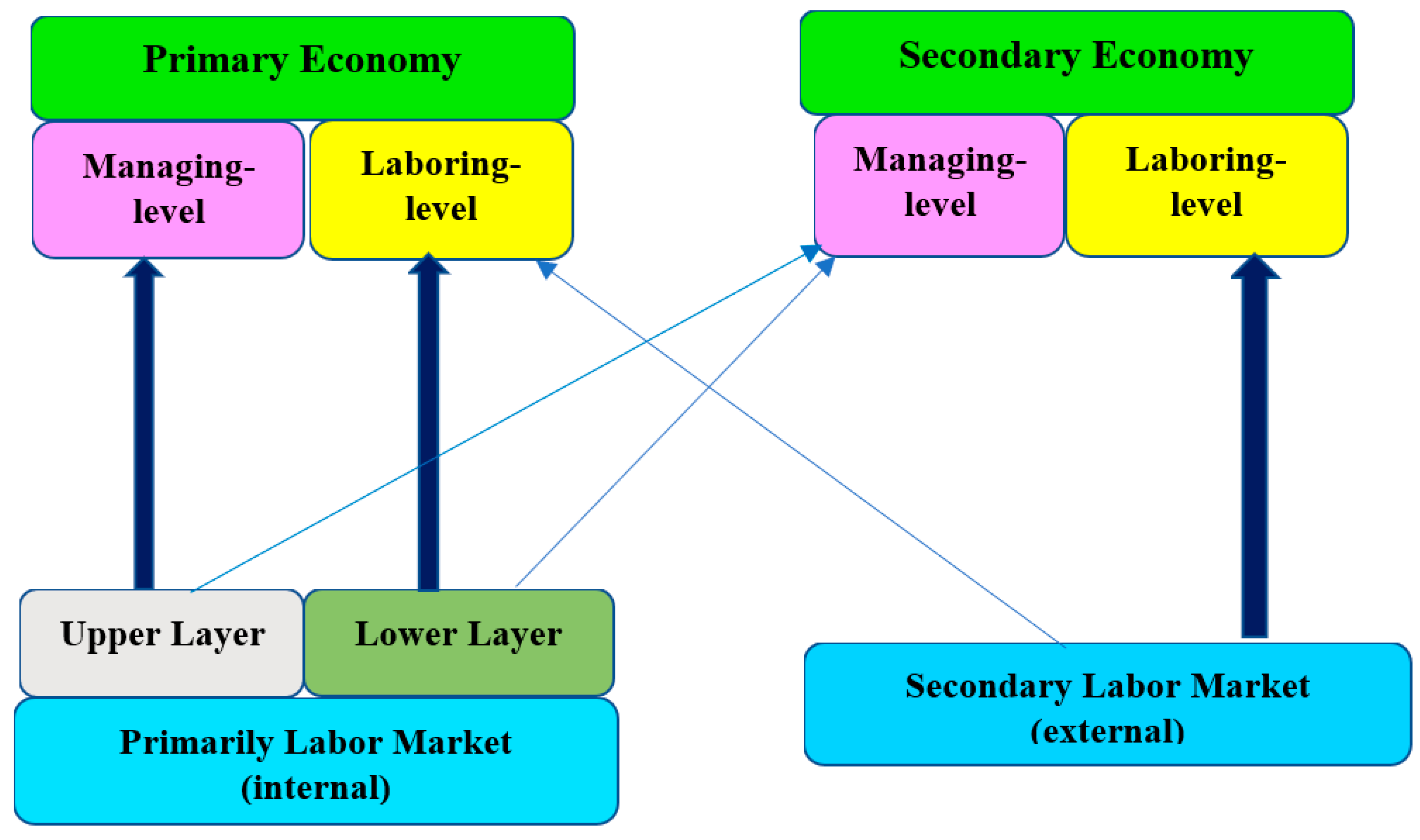
4. Methodology
5. Remarks on Current Outcomes
5.1. Employment Challenges
5.2. The Decline in the Employment and Multi-Facet Effects
6. Conclusions
An Intersectional Overview
Funding
Institutional Review Board Statement
Informed Consent Statement
Conflicts of Interest
References
- European Migration Network Study. Integration of Migrant Women. European Commission. 2022. Available online: https://home-affairs.ec.europa.eu/system/files/2022-09/EMN_STUDY_integration-migrant-women_23092022.pdf (accessed on 18 July 2022).
- Eurostat. EU Population in 2020: Almost 448 Million. Eurostat. 2020. Available online: https://ec.europa.eu/eurostat/documents/2995521/11081093/3-10072020-AP-EN.pdf/d2f799bf-4412-05cc-a357-7b49b93615f1 (accessed on 10 July 2022).
- OECD. What Is the Impact of the COVID-19 Pandemic on Immigrants and Their Children? OECD. 2020. Available online: https://www.oecd.org/coronavirus/policy-responses/what-is-the-impact-of-the-covid-19-pandemic-on-immigrants-and-their-children-e7cbb7de/ (accessed on 13 November 2022).
- European Parliament. Precarious Employment in Europe: Patterns, Trends and Policy Strategies. 2016. Available online: https://www.europarl.europa.eu/RegData/etudes/STUD/2016/587285/IPOL_STU (accessed on 8 October 2022).
- Bevelander, P. The Employment Status of Immigrant Women: The Case of Sweden. Int. Migr. Rev. 2005, 39, 173–202. Available online: http://www.jstor.org/stable/27645480 (accessed on 24 August 2022). [CrossRef]
- Eurostat. Translate Migrant Integration Statistics—Labour Market Indicators. Statistics Explained. 2021. Available online: https://ec.europa.eu/eurostat/statistics-explained/index.php?title=Migrant_integration_statistics_%E2%80%93_labour_market_indicators (accessed on 12 October 2022).
- ILO. Gender Equality at the Heart of Decent Work. 2009. Available online: https://www.ilo.org/wcmsp5/groups/public/@ed_norm/@relconf/documents/meetingdocument/wcms_105119.pdf (accessed on 10 May 2022).
- ILO. Global Employment Trends for Youth 2020. 2020. Available online: https://www.ilo.org/wcmsp5/groups/public/---dgreports/---dcomm/---publ/documents/publication/wcms_737648.pdf (accessed on 8 May 2022).
- Lodovici, M.S. Making a Success of Integrating Immigrants in the Labour Market. 2010. Available online: https://ec.europa.eu/social/BlobServlet?docId=8218&langId=en (accessed on 12 August 2022).
- Cerrato, J.; Cifre, E. Gender Inequality in Household Chores and Work-Family Conflict. Front. Psychol. 2018, 9, 1330. [Google Scholar] [CrossRef]
- Marks, J.; Bun, L.C.; McHale, S.M. Family Patterns of Gender Role Attitudes. Sex Roles 2009, 61, 221–234. [Google Scholar] [CrossRef] [PubMed]
- Pailhé, A.; Solaz, A.; Stanfors, M. The Great Convergence? Gender and Unpaid Work in Europe and the United States. 2020. Available online: https://www.ed.lu.se/media/ed/papers/working_papers/LPED_2020_1.pdf (accessed on 27 September 2022).
- European Parlemant. Integration of Refugees in Austria, Germany and Sweden: Comparative Analysis. 2018. Available online: https://www.europarl.europa.eu/RegData/etudes/STUD/2018/614200/IPOL_STU (accessed on 5 October 2022).
- Reino, M.F.; Rienzo, C. Migrants in the UK Labour Market: An Overview. 2021. Available online: https://migrationobservatory.ox.ac.uk/wp-content/uploads/2019/07/COMPAS-Briefing-Migrants-in-the-UK-labour-market-an-overview.pdf (accessed on 15 October 2022).
- ILO. ILO Global Estimates on Migrant Workers: Results and Methodology; Special Focus on Migrant Domestic Workers. 2015. Available online: https://www.ilo.org/wcmsp5/groups/public/---dgreports/---dcomm/documents/publication/wcms_436343.pdf (accessed on 4 August 2022).
- OECD. How Are Refugees Faring on the Labour Market in Europe? Available online: https://ec.2016.europa.eu/social/BlobServlet?docId=16130&langId=en (accessed on 29 June 2022).
- Calmfors, L.; Gassen, N.S. Integrating Immigrants into the Nordic Labour Markets. Nordisk Ministerråd. 2019. Available online: https://norden.diva-portal.org/smash/get/diva2:1317928/FULLTEXT01.pdf (accessed on 24 August 2022).
- Kil, T.; Neels, K.; Wood, J.; de Valk, H. Employment After Parenthood: Women of Migrant Origin and Natives Compared. Eur. J. Popul. = Rev. Eur. Demogr. 2017, 34, 413–440. [Google Scholar] [CrossRef]
- Amo-Agyei, S. The Migrant Pay Gap: Understanding Wage Differences between Migrants and Nationals. ILO. 2020. Available online: https://www.ilo.org/wcmsp5/groups/public/---ed_protect/---protrav/---migrant/documents/publication/wcms_763803.pdf (accessed on 7 September 2022).
- ILO. ILO Global Estimates on International Migrant Workers Labour Migration; Results and Methodology. 2017. Available online: https://www.ilo.org/wcmsp5/groups/public/---dgreports/---dcomm/---publ/documents/publication/wcms_652001.pdf (accessed on 21 August 2022).
- ILO. Changing Attitudes and Behaviour towards Women Migrant Workers in ASEAN: Technical Regional Meeting. 2018. Available online: https://www.ilo.org/wcmsp5/groups/public/---asia/---ro-bangkok/documents/publication/wcms_715939.pdf (accessed on 15 August 2022).
- ILO. The Social Construction of Migrant Care Work. 2019. Available online: https://www.ilo.org/wcmsp5/groups/public/---ed_protect/---protrav/---migrant/documents/publication/wcms_674622.pdf (accessed on 11 May 2022).
- UN Migration. World Migration Report 2020. Available online: https://publications.iom.int/system/files/pdf/wmr_2020.pdf (accessed on 5 September 2022).
- ILO. Non-Standard Employment around the World. 2016. Available online: https://www.ilo.org/wcmsp5/groups/public/---dgreports/---dcomm/---publ/documents/publication/wcms_534326.pdf (accessed on 20 June 2022).
- Reich, M.; Gordon, D.M.; Edwards, R.C. A Theory of Labor Market Segmentation. Am. Econ. Rev. 1973, 63, 359–365. Available online: http://www.jstor.org/stable/1817097 (accessed on 2 July 2022).
- Doeringer, P.B.; Piore, M.J. Internal Labor Markets, Technological Change, and Labor Force Adjustment; D.C. Heath and Company: New York, NY, USA, 1971. [Google Scholar]
- Piore, M.J. On-the-Job Training in the Dual Labor Market: Public and Private Responsibilities in On-the-Job Training of Disadvantaged Workers; Industrial Relations Research Association: Champaign, IL, USA, 1969. [Google Scholar]
- Kalleberg, A.L.; Sorensen, A.B. The Sociology of Labor Markets. Annu. Rev. Sociol. 1979, 5, 351–379. Available online: http://www.jstor.org/stable/2945959 (accessed on 14 November 2022). [CrossRef]
- Piore, M.J. Notes for a Theory of Labor Market Stratification. 1972. Available online: https://dspace.mit.edu/handle/1721.1/64001 (accessed on 10 October 2022).
- Aigner, D.J.; Cain, G.G. Statistical Theories of Discrimination in Labor Markets. ILR Rev. 1977, 30, 175–187. [Google Scholar] [CrossRef]
- Alexis, M. A Theory of Labor Market Discrimination with Interdependent Utilities. Am. Econ. Rev. 1973, 63, 296–302. Available online: http://www.jstor.org/stable/1817089 (accessed on 23 August 2022).
- Freiburghaus, D.; Schmid, G. Theorie Der Segmentierung von Arbeitsmärkten: Darstellung Und Kritik Neuerer Ansätze Mit Besonderer Berücksichtigung Arbeitsmarktpolitischer Konsequenzen. Leviathan 1975, 3, 417–448. Available online: http://www.jstor.org/stable/23983963 (accessed on 10 September 2022).
- Massey, D.S.; Arango, J.; Hugo, G.; Kouaouci, A.; Pellegrino, A.; Taylor, J.E. Theories of International Migration: A Review and Appraisal. Popul. Dev. Rev. 1993, 19, 431–466. [Google Scholar] [CrossRef]
- Darity, W.A.; Goldsmith, A.H. Social Psychology, Unemployment and Macroeconomics. J. Econ. Perspect. 1996, 10, 121–140. [Google Scholar] [CrossRef]
- Chauvin, J.P. Gender-Segmented Labor Markets and the Effects of Local Demand Shocks; Inter-American Development Bank: Washington, DC, USA, 2018. [Google Scholar] [CrossRef]
- Hori, H. Labor Market Segmentation and the Gender Wage Gap. Jpn. Labor Rev. 2009, 6. Available online: https://www.jil.go.jp/english/JLR/documents/2009/JLR21_hori.pdf (accessed on 14 May 2022).
- Waddoups, J.; Assane, D. Mobility and Gender in a Segmented Labor Market: A Closer Look. Am. J. Econ. Sociol. 1993, 52, 399–412. Available online: http://www.jstor.org/stable/3487464 (accessed on 16 October 2022). [CrossRef]
- Bettio, F.; Verashchagina, A. Gender Segregation in the Labour Market; Root Causes, Implications and Policy Responses in the EU. European Commission’s Expert Group on Gender and Employment (EGGE). 2009. Available online: https://ec.europa.eu/social/BlobServlet?docId=3799&langId=en (accessed on 25 May 2022).
- Deakin, S. Working Paper No. 52, ‘Addressing Labour Market Segmentation: The Role of Labour Law’. 9 October 2013. Available online: https://www.ilo.org/ifpdial/information-resources/publications/WCMS_223702/lang--en/index.htm (accessed on 10 November 2022).
- Grimshaw, D.; Fagan, C.; Hebson, G.; Tavora, I. A new labour market segmentation approach for analysing inequalities. In Making Work More Equal; Manchester University Press: Manchester, UK, 2017. [Google Scholar] [CrossRef]
- Creswell, J.W. Research Design. Qualitative, Quantitative, and Mixed Methods Approaches; SAGE Publications: New York, NY, USA, 2017. [Google Scholar]
- Tight, M. Documentary Research in the Social Sciences; Sage Publications: New York, NY, USA, 2019. [Google Scholar]
- Henn, M.; Weinstein, M.; Foard, N. A Critical Introduction to Social Research; SAGE: New York, NY, USA, 2009. [Google Scholar]
- Mogalakwe, M. The Use of Documentary Research Methods in Social Research. Afr. Sociol. Rev./Rev. Afr. Sociol. 2006, 10, 221–230. Available online: http://www.jstor.org/stable/afrisocirevi.10.1.221 (accessed on 8 August 2022).
- European Commission. Women in the Labour Market—European Commission. European Commission. 2021. Available online: https://ec.europa.eu/info/sites/default/files/european-semester_thematic-factsheet_labour-force-participation-women_en_0.pdf (accessed on 15 May 2022).
- ILO. World Employment and Social Outlook. 2020. Available online: https://www.ilo.org/wcmsp5/groups/public/---dgreports/---dcomm/---publ/documents/publication/wcms_734455.pdf (accessed on 7 May 2022).
- Jesline, J.; Romate, J.; Rajkumar, E.; George, A.J. The plight of migrants during COVID-19 and the impact of circular migration in India: A systematic review. Humanit. Soc. Sci. Commun. 2021, 8, 231. [Google Scholar] [CrossRef]
- ILO. World Employment and Social Outlook|Trends 2022. 2022. Available online: https://www2019.ilo.org/wcmsp5/groups/public/---dgreports/---dcomm/---publ/documents/publication/wcms_834081.pdf (accessed on 11 June 2022).
- OECD. Women at the Core of the Fight against the COVID-19 Crisis. 2020. Available online: https://read.oecd-ilibrary.org/view/?ref=127_127000-awfnqj80me&title=Women-at-the-core-of-the-fight-against-COVID-19-crisis&_ga=2.250024134.1514930723.1638746954-1587338467.1638457788 (accessed on 28 August 2022).
- UN Women. COVID-19 and Its Economic Toll on Women: The Story Behind the Numbers. 2020. Available online: https://www.unwomen.org/en/news/stories/2020/9/feature-covid-19-economic-impacts-on-women (accessed on 18 October 2022).
- Cain Miller, C. The Pandemic Created a Child-Care Crisis. Mothers Bore the Burden. The New York Times. 17 May 2021. Available online: https://www.nytimes.com/interactive/2021/05/17/upshot/women-workforce-employment-covid.html (accessed on 10 September 2022).
- ILO. COVID-19 and the World of Work. Seventh Edition. 2021. Available online: https://www.ilo.org/wcmsp5/groups/public/@dgreports/@dcomm/documents/briefingnote/wcms_767028.pdf (accessed on 10 May 2022).
- WGEA (Workplace Gender Equality Agency). Gendered Impacts of COVID-19. 2020. Available online: https://www.wgea.gov.au/sites/default/files/documents/Gendered%20impacts%20of%20COVID19_0.pdf (accessed on 10 October 2022).
- OECD. Labour Market Outcomes of Immigrants and Integration Policies in OECD Countries. International Migration Outlook 2020|OECD iLibrary. 2020. Available online: https://www.oecd-ilibrary.org/sites/0c0cc42a-en/index.html?itemId=%2Fcontent%2Fcomponent%2F0c0cc42a-en (accessed on 12 October 2022).
- Rubery, J.; Tavora, I. The COVID-19 crisis and gender equality: Risks and opportunities. In Social Policy in the European Union: State of Play; UNDP: New York, NY, USA, 2020; pp. 71–96. [Google Scholar]
- Derndorfer, J.; Disslbacher, F.; Lechinger, V.; Mader, K.; Six, E. Home, sweet home? The impact of working from home on the division of unpaid work during the COVID-19 lockdown. PLoS ONE 2021, 16, e0259580. [Google Scholar] [CrossRef]
- WHO. Women on the Move; Migration, Care Work and Health. 2017. Available online: https://apps.who.int/iris/bitstream/handle/10665/259463/9789241513142-eng.pdf (accessed on 24 August 2022).
- WHO. Women and Children Experienced Higher Rates of Violence in Pandemic’s First Months. 2021. Available online: https://www.euro.who.int/en/health-topics/disease-prevention/violence-and-injuries/news/news/2021/11/women-and-children-experienced-higher-rates-of-violence-in-pandemics-first-months (accessed on 15 September 2022).
- European Institute for Gender Equality. Gender Equality and the Socio-Economic Impact of the COVID-19 Pandemic. European Institute for Gender Equality. 26 May 2021. Available online: https://eige.europa.eu/publications/gender-equality-and-socio-economic-impact-covid-19-pandemic (accessed on 12 October 2022).
- United Nation Migration. Taking Action against Violence and Discrimination Affecting Migrant Women and Girls. 2018. Available online: https://www.iom.int/sites/g/files/tmzbdl486/files/2018-07/violence_against_women_infosheet2013.pdf (accessed on 12 August 2022).
- UNFPA (United Nations Population Fund). Millions more Cases of Violence, Child Marriage, Female Genital Mutilation, and Unintended Pregnancy Expected Due to the COVID-19 Pandemic. 2020. Available online: https://www.unfpa.org/news/millions-more-cases-violence-child-marriage-female-genital-mutilation-unintended-pregnancies (accessed on 6 September 2022).
- ESCAP (Moving Forward Together of United Nations). The COVID-19 Pandemic and Violence Against Women in Asia and the Pacific. 2021. Available online: https://reliefweb.int/sites/reliefweb.int/files/resources/SDD_Policy_Paper_Covid-19-VAW.pdf (accessed on 8 October 2022).
- Foley, L.; Piper, N. COVID-19 and Women Migrant Workers: Impacts and Implications. International Organization for Migration. 2020. Available online: https://publications.iom.int/books/covid-19-and-women-migrant-workers-impacts-and-implications (accessed on 13 November 2022).
- UNICEF. Situational Analysis of Women and Girls in the Middle East and North Africa. UNICEF Middle East and North Africa. 1 November 2021. Available online: https://www.unicef.org/mena/reports/situational-analysis-women-and-girls-middle-east-and-north-africa (accessed on 10 October 2022).
- Ennser-Kananen, J.; Pettitt, N. I want to speak like the other people”: Second language learning as a virtuous spiral for migrant women? Int. Rev. Educ. 2017, 63, 583–604. Available online: http://www.jstor.org/stable/44980150 (accessed on 12 August 2022). [CrossRef]
- Bolzani, D.; Crivellaro, F.; Grimaldi, R. Highly skilled, yet invisible. The potential of migrant women with a stemm background in Italy between intersectional barriers and resources. Gend. Work. Organ. 2021, 28, 2132–2157. [Google Scholar] [CrossRef]
- Jones, K.; Piper, N.; Mudaliar, S. Locked Down and in Limbo: The Global Impact of COVID-19 on Migrant Worker Rights and Recruitment. Fair Recruitment: Locked Down and in Limbo: The Global Impact of COVID-19 on migrant worker rights and Recruitment. 22 November 2021. Available online: https://www.ilo.org/global/topics/fair-recruitment/publications/WCMS_821985/lang--en/index.htm (accessed on 13 November 2022).
- Schieckoff, B.; Sprengholz, M. The labor market integration of immigrant women in Europe: Context, theory, and evidence. SN Soc. Sci. 2021, 1, 276. [Google Scholar] [CrossRef]
- OECD. The Unequal Impact of COVID-19: A Spotlight on Frontline Workers, Migrants, and Racial/Ethnic Minorities. OECD. 2022. Available online: https://www.oecd.org/coronavirus/policy-responses/the-unequal-impact-of-covid-19-a-spotlight-on-frontline-workers-migrants-and-racial-ethnic-minorities-f36e931e/ (accessed on 11 October 2022).
- European Institute for Gender Equality. Education and Training of Migrant Women: What Works? European Institute for Gender Equality. 13 May 2020. Available online: https://eige.europa.eu/news/education-and-training-migrant-women-what-works (accessed on 12 October 2022).
- European Institute for Gender Equality. COVID-19 Wave of Violence against Women Shows EU Countries Still Lack Proper Safeguards. 2021. Available online: https://eige.europa.eu/news/covid-19-wave-violence-against-women-shows-eu-countries-still-lack-proper-safeguards (accessed on 15 May 2022).
- Castles, S. Migration, Precarious Work, and Rights: Historical and Current Perspectives. In Migration, Precarity, & Global Governance Essay; Schierup, C.-U., Ed.; OXFORD University Press: Oxford, UK, 2015. [Google Scholar]
- Gimenez, M.E. Global Capitalism and Women: From Feminist Politics. In Marx, Women, and Capitalist Social Reproduction Marxist Feminist Essays; Haymarket Books: Chicago, IL, USA, 2019. [Google Scholar]
- Weeks, K. The Problem with Work: Feminism, Marxism, Antiwork Politics, and Postwork Imaginaries; Duke University Press: Durham, NC, USA, 2011. [Google Scholar]
- Mies, M. Patriarchy and Accumulation on a World Scale: Women in the International Division of Labour; Bloomsbury Academic: London, UK, 2022. [Google Scholar]
- UN Women. Un Women Reveals Concerning Regression in Attitudes towards Gender Roles during Pandemic in New Study. UN Women—Headquarters. 22 June 2022. Available online: https://www.unwomen.org/en/news-stories/press-release/2022/06/un-women-reveals-concerning-regression-in-attitudes-towards-gender-roles-during-pandemic-in-new-study (accessed on 12 October 2022).
- ILO. Women and Men Migrant Workers: Moving towards Equal Rights and Opportunities. 2014. Available online: https://www.ilo.org/wcmsp5/groups/public/@dgreports/@gender/documents/publication/wcms_101118.pdf (accessed on 12 May 2022).
- Sharp, M. The labour market impacts of female internal migration: Evidence from the end of apartheid. Reg. Sci. Urban Econ. 2021, 91, 103624. [Google Scholar] [CrossRef]
- Blekesaune, M. Employment among female immigrants to Europe. Acta Sociol. 2021, 64, 331–345. [Google Scholar] [CrossRef]
- Sengenberger, W.; Wilkinson, F. ‘Globalization and labor standards,’ In Managing the Global Economy; Michie, J., Smith, J.G., Eds.; Oxford University Press: Oxford, UK, 1995. [Google Scholar]
- Hartmann, H. Capitalism, Patriarchy, and Job Segregation by Sex. Signs 1976, 1, 137–169. Available online: http://www.jstor.org/stable/3173001 (accessed on 2 August 2022). [CrossRef]
- Crenshaw, K. Mapping the Margins: Intersectionality, Identity Politics, and Violence against Women of Color. Stanf. Law Rev. 1991, 43, 1241–1299. [Google Scholar] [CrossRef]
- Browne, I.; Misra, J. The Intersection of Gender and Race in the Labor Market. Annu. Rev. Sociol. 2003, 29, 487–513. Available online: http://www.jstor.org/stable/30036977 (accessed on 26 May 2022). [CrossRef]
- Smith, R.A. Race, Gender, and Authority in the Workplace: Theory and Research. Annu. Rev. Social. 2002, 28, 509–542. Available online: http://www.jstor.org/stable/3069251 (accessed on 22 October 2022). [CrossRef]
- Hogan, R. Class, Race, and Gender Inequality. Race Gend. Cl. 2001, 8, 61–93. Available online: http://www.jstor.org/stable/41674972 (accessed on 19 September 2022).
- Salter, P.S.; Adams, G.; Perez, M.J. Racism in the Structure of Everyday Worlds: A Cultural-Psychological Perspective. Curr. Dir. Psychol. Sci. 2018, 27, 150–155. [Google Scholar] [CrossRef]
- Cheng, J.E. Islamophobia, Muslimophobia or racism? Parliamentary discourses on Islam and Muslims in debates on the minaret ban in Switzerland. Discourse Soc. 2015, 26, 562–586. Available online: https://www.jstor.org/stable/26376401 (accessed on 10 September 2022). [CrossRef]
- Hill Collins, P. Black Sexual Politics: African Americans, Gender, and the New Racism, 1st ed.; Routledge: Oxfordshire, UK, 2004. [Google Scholar] [CrossRef]
- Hall, S. Race Articulation and Societies Structured in Dominance. 1980. Available online: https://unesdoc.unesco.org/ark:/48223/pf0000040979 (accessed on 14 November 2022).
- Alexander, C. Stuart hall and ‘race’. Cult. Stud. 2009, 23, 457–482. [Google Scholar] [CrossRef]
- MacKinnon, C.A. Toward a feminist theory of the State; Harvard University Press: Cambridge, MA, USA, 1991. [Google Scholar]
- ENAR. Racism & Discrimination in Employment in Europe 2013–2017. European Website on Integration. 2018. Available online: https://ec.europa.eu/migrant-integration/library-document/enar-shadow-report-racism-discrimination-employment-europe-2013-2017_en (accessed on 14 November 2022).
- Bonilla-Silva, E. Rethinking Racism: Toward a Structural Interpretation. Am. Sociol. Rev. 1997, 62, 465–480. [Google Scholar] [CrossRef]
- Kabeer, N.; Razavi, S.; van der Meulen Rodgers, Y. Feminist economic perspectives on the COVID-19 pandemic. Fem. Econ. 2021, 27, 1–29. [Google Scholar] [CrossRef]
- Gilbert, M.R. “Race,” Space, and Power: The Survival Strategies of Working Poor Women. Ann. Assoc. Am. Geogr. 1998, 88, 595–621. Available online: http://www.jstor.org/stable/2564094 (accessed on 22 May 2022). [CrossRef]
- Powell, C. Color of Covid and Gender of Covid: Essential Workers, not Disposable People. Yale Law School Legal Scholarship Repository. 25 November 2021. Available online: https://openyls.law.yale.edu/handle/20.500.13051/7137 (accessed on 14 November 2022).
- Bonilla-Silva, E. Feeling Race: Theorizing the Racial Economy of Emotions. Am. Sociol. Rev. 2019, 84, 1–25. [Google Scholar] [CrossRef]
- Zinn, M.B.; Hondagneu-Sotelo, P.; Messner, M.A. Gender through the prism of Difference; Oxford University Press: Cambridge, MA, USA, 2020. [Google Scholar]
- McCall, L. The Complexity of Intersectionality. Signs 2005, 30, 1771–1800. [Google Scholar] [CrossRef]
- Kreckel, R. Unequal opportunity structure, and labour market segmentation. Sociology 1980, 14, 525–550. Available online: http://www.jstor.org/stable/42852233 (accessed on 13 August 2022). [CrossRef]
- Samantroy, E.; Nandi, S. Gender, Unpaid Work and Care in India; Routledge: Oxfordshire, UK, 2022. [Google Scholar]
- Addati, L.; Cattaneo, U.; Esquivel, V.; Valarino, I. Care Work and Care Jobs for the Future of Decent Work. 2018. Available online: https://www.ilo.org/wcmsp5/groups/public/---dgreports/---dcomm/---publ/documents/publication/wcms_633166.pdf (accessed on 15 May 2022).
- Eichhorst, W.; Marx, P.; Wehner, C. Labor Market Reforms in Europe: Towards more flexicure labor markets? SSRN Electron. J. 2017. [Google Scholar] [CrossRef]
- Grimshaw, D.; Rubery, J. The motherhood pay gap: A review of the issues, theory and international evidence. ILO. 6 March 2015. Available online: https://www.ilo.org/global/publications/working-papers/WCMS_348041/lang--en/index.htm (accessed on 15 November 2022).
- Solati, F. Women, Work, and Patriarchy in the Middle East and North Africa; Springer: Berlin/Heidelberg, Germany, 2018. [Google Scholar]
- European Commission. Jobs and Economy during the Coronavirus Pandemic. 2021. Available online: https://ec.europa.eu/info/live-work-travel-eu/coronavirus-response/jobs-and-economy-during-coronavirus-pandemic_en (accessed on 6 August 2022).
- Catarino, C.; Kontos, M.; Shinozaki, K. Family Matters: Migrant Domestic and Care Work and the Issue of Recognition. In Paradoxes of Integration: Female Migrants in Europe. International Perspectives on Migration; Anthias, F., Kontos, M., Morokvasic-Müller, M., Eds.; Springer: Dordrecht, The Netherlands, 2013; Volume 4. [Google Scholar] [CrossRef]
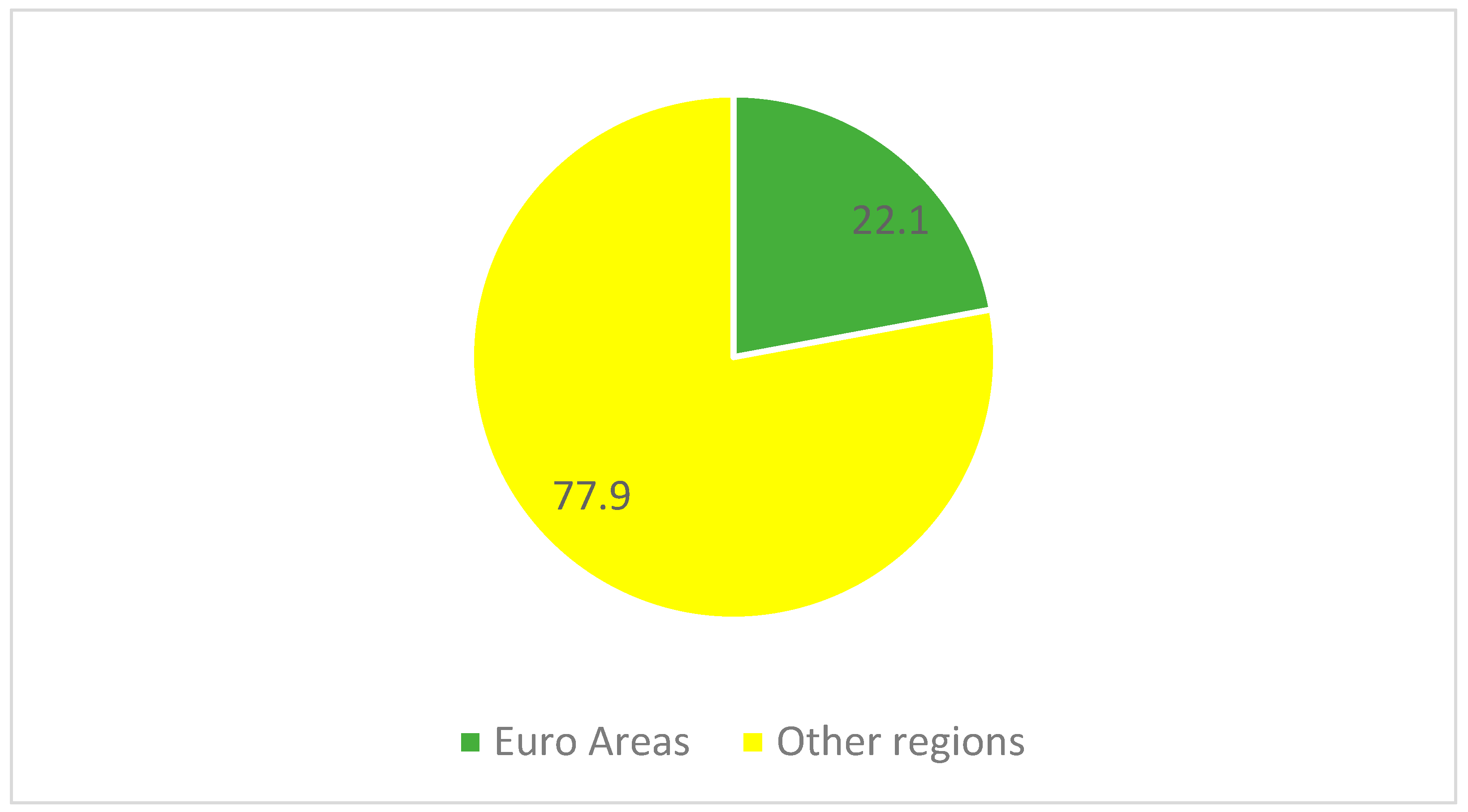
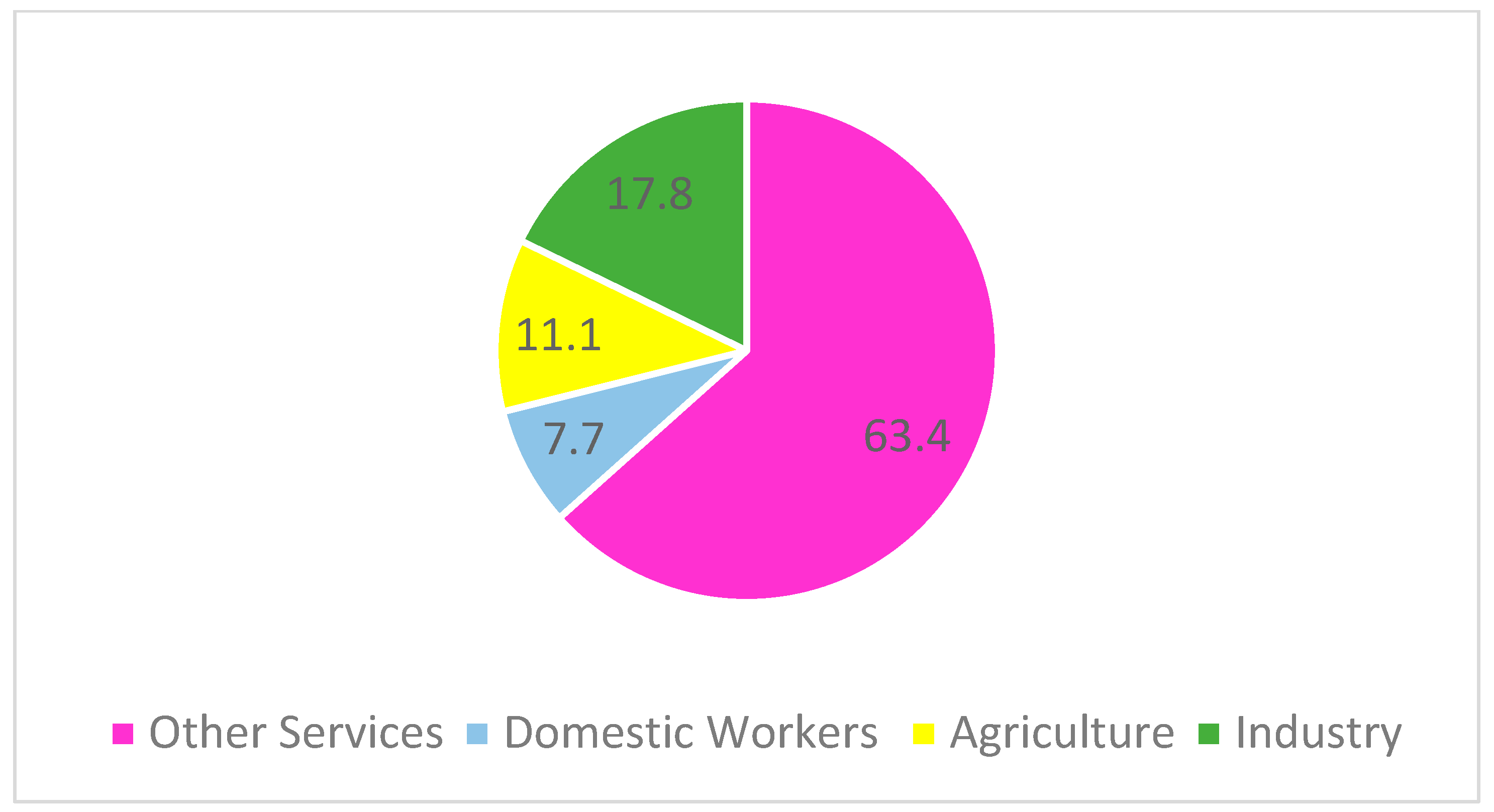




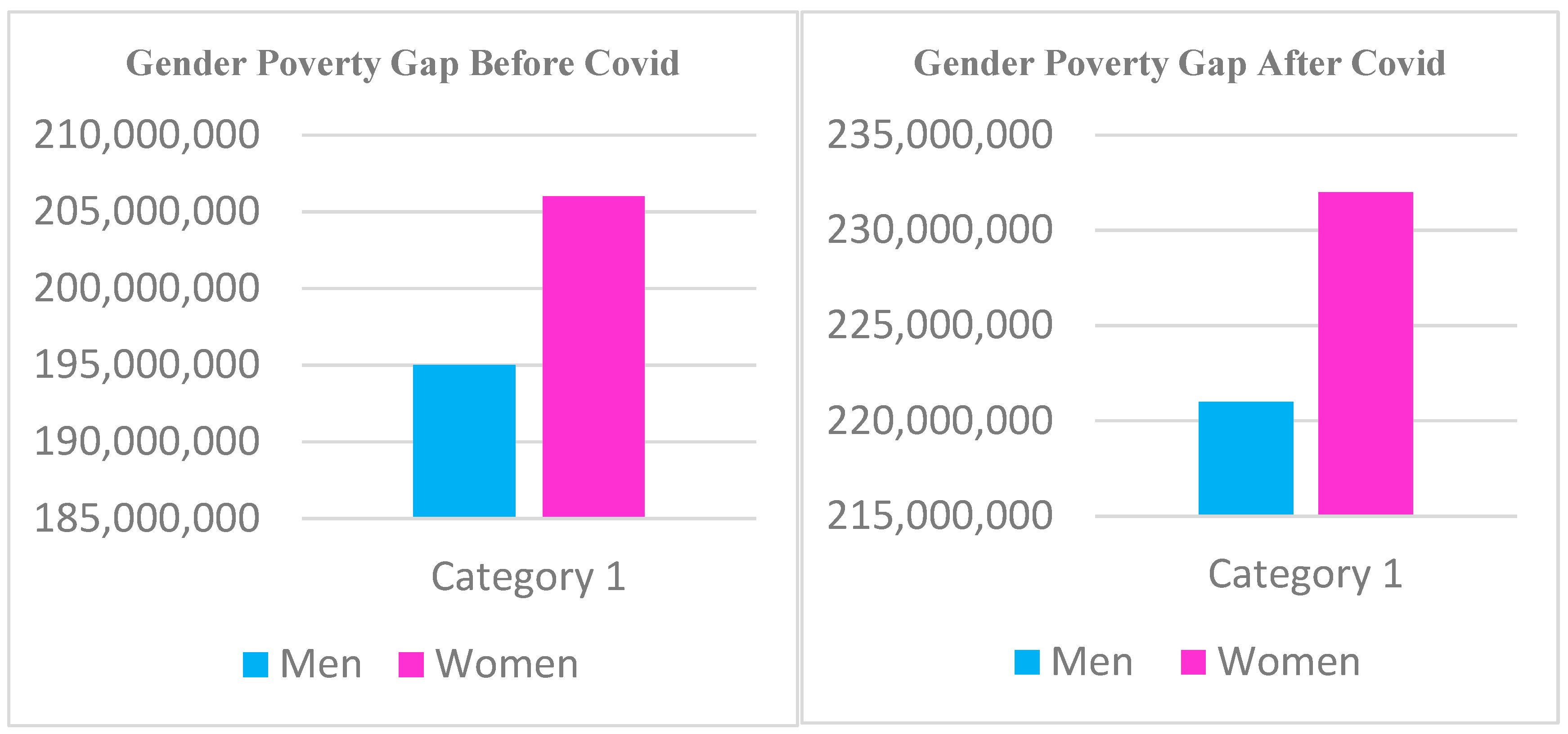
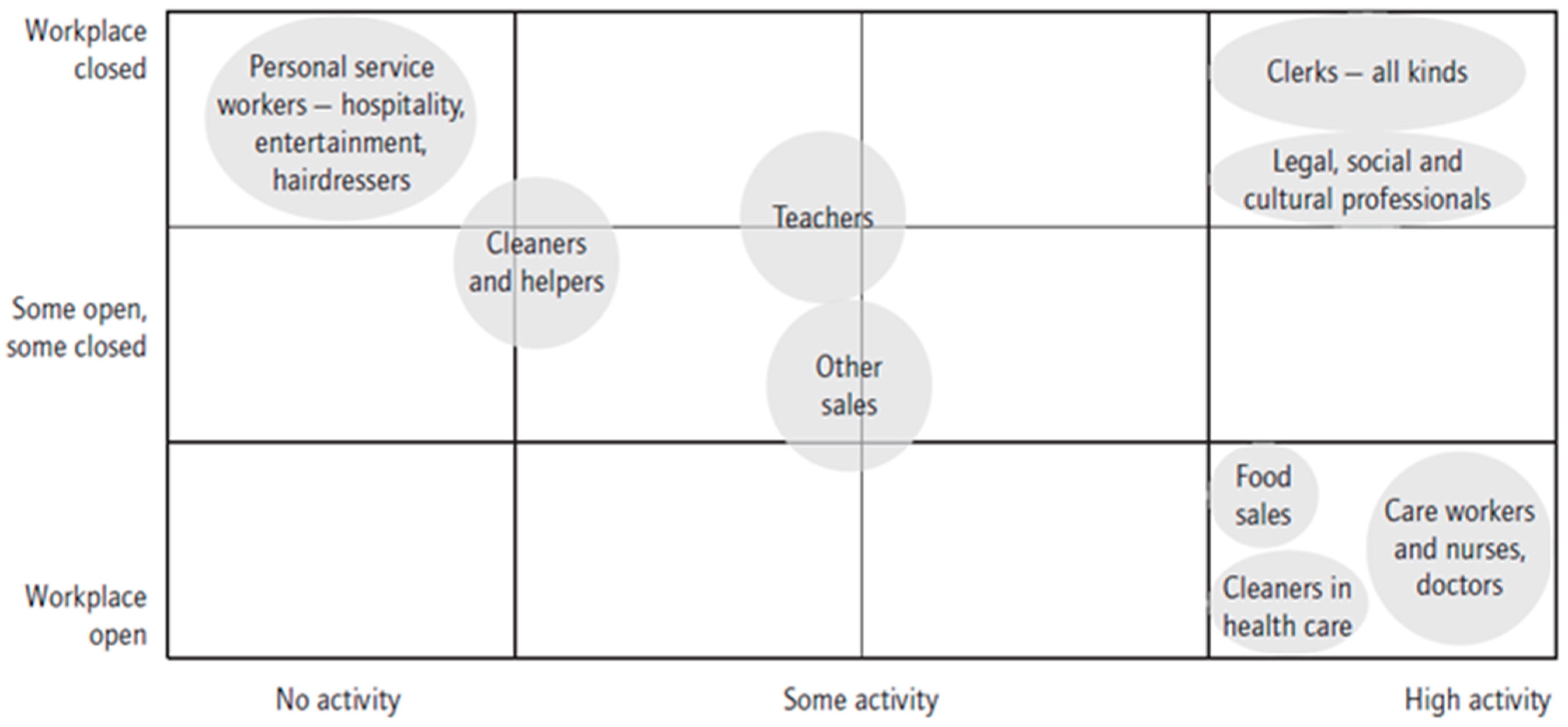


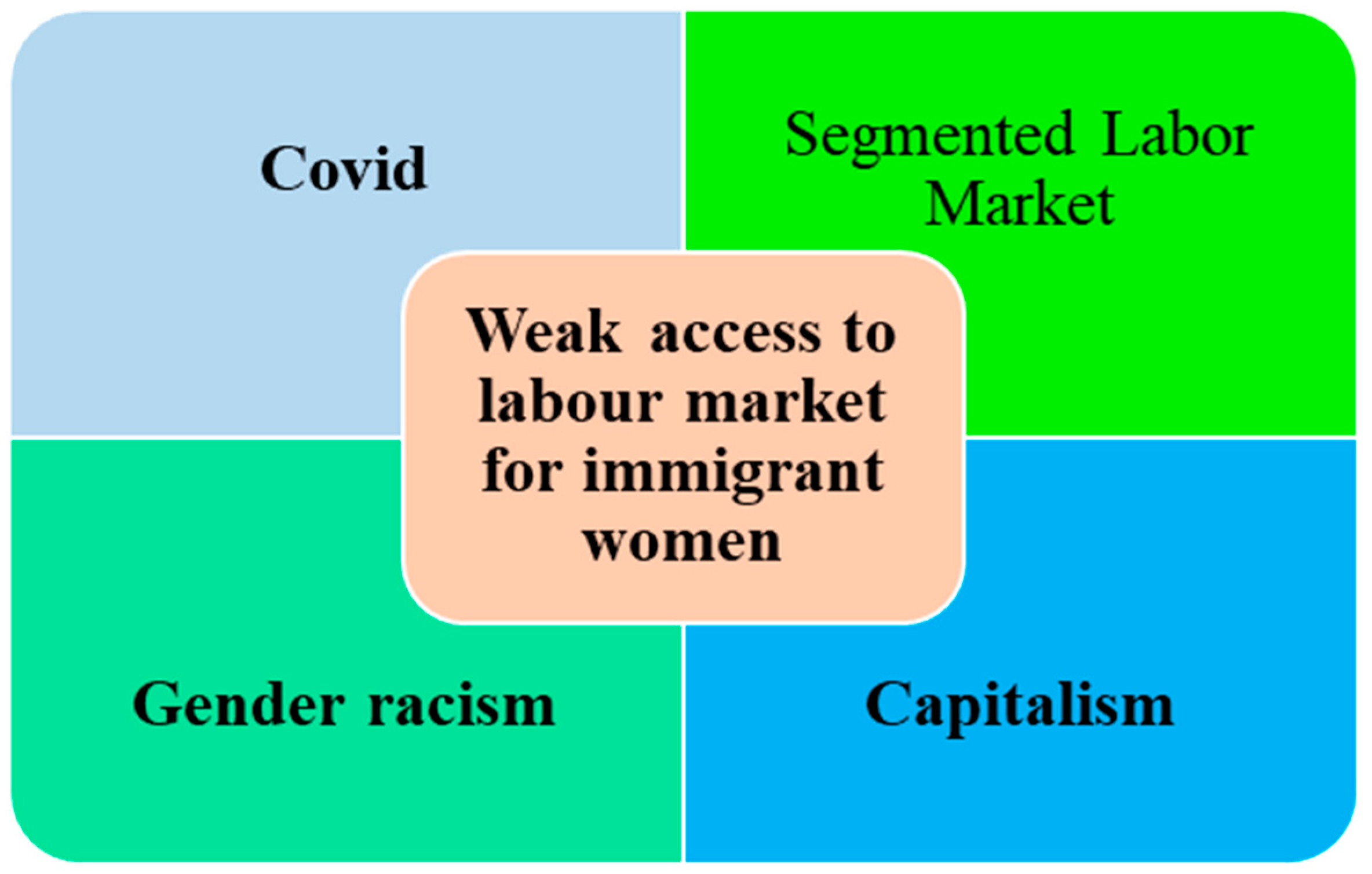
| Themes | Concepts |
|---|---|
| Employment Challenges | Lockdown mainly affects manual and non-manual routine activities; the reduction of system-relevant jobs; the closure of care and educational institutions, which is a greater burden for migrant women. |
| Decline in Employment | Migrant women were particularly affected by the loss of their jobs; Increased physical and psychological work pressure in the health and care sector for migrant women; women of immigrant background are particularly likely to work in the industries most affected by the pandemic; female migrants from MENA origin are significantly more affected by the crisis; migrant women are more affected by containment measures than other groups; gender-specific roles and division of labor among the migrant community; gender segregation in favor of men; experiencing a higher level of violence among migrant women; financial dependency to intimate partner; exacerbating intimate partner violence as an output. |
| Sector | Percent of Participation |
|---|---|
| Total | 18.7 |
| Manufacture of goods | 20 |
| Accommodation and catering | 45 |
| Trade: maintenance and repair of motor vehicles | 18 |
| Provision of other economic services | 45 |
| building | 12 |
| Transportation and storage | 20 |
| Health and social services | 16 |
| Provision of freelance, academic, and tech. services | 16 |
| Public administration, defense, social insurance | 6 |
| Education and instruction | 21 |
| Agriculture and forestry; fishing | 45 |
| Others | 16 |
Publisher’s Note: MDPI stays neutral with regard to jurisdictional claims in published maps and institutional affiliations. |
© 2022 by the author. Licensee MDPI, Basel, Switzerland. This article is an open access article distributed under the terms and conditions of the Creative Commons Attribution (CC BY) license (https://creativecommons.org/licenses/by/4.0/).
Share and Cite
Hamedanian, F. Access to the European Labor Market for Immigrant Women in the Wake of the COVID Pandemic. World 2022, 3, 957-978. https://doi.org/10.3390/world3040054
Hamedanian F. Access to the European Labor Market for Immigrant Women in the Wake of the COVID Pandemic. World. 2022; 3(4):957-978. https://doi.org/10.3390/world3040054
Chicago/Turabian StyleHamedanian, Fatemeh. 2022. "Access to the European Labor Market for Immigrant Women in the Wake of the COVID Pandemic" World 3, no. 4: 957-978. https://doi.org/10.3390/world3040054
APA StyleHamedanian, F. (2022). Access to the European Labor Market for Immigrant Women in the Wake of the COVID Pandemic. World, 3(4), 957-978. https://doi.org/10.3390/world3040054







